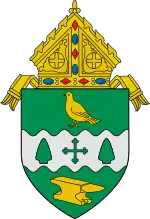James William Malone
James William Malone (March 8, 1920 – April 9, 2000) was an American prelate of the Roman Catholic Church. He served as bishop of the Diocese of Youngstown in Ohio from 1968 to 1995.[1]
James William Malone | |
|---|---|
| Bishop of Youngstown titular bishop of Alabanda | |
| Church | Roman Catholic Church |
| See | Diocese of Youngstown |
| Appointed | May 2, 1968 |
| In office | May 2, 1968— December 5, 1995 |
| Predecessor | Emmet M. Walsh |
| Successor | Thomas Joseph Tobin |
| Orders | |
| Ordination | May 26, 1945 by James A. McFadden |
| Consecration | March 24, 1960 by Emmet M. Walsh |
| Personal details | |
| Born | March 8, 1920 Youngstown, Ohio, USA |
| Died | April 9, 2000 (aged 80) Youngstown, Ohio, USA |
| Previous post(s) | Auxiliary Bishop of Youngstown (1960-1968) |
| Education | St. Mary's Seminary Catholic University of America |
Ordination history of James William Malone | |||||||||
|---|---|---|---|---|---|---|---|---|---|
| |||||||||
| |||||||||
Biography
Early life
James Malone was born in Youngstown, Ohio, on March 8, 1920. The son of a steelworker, Malone worked in a steel mill for a year to raise money for college.[2] He attend St. Mary's Seminary in Wickliffe, Ohio. He later received a Doctor of School Administration degree from the Catholic University of America in Washington, D.C.[3]
Malone was ordained a priest by Bishop James A. McFadden for the Diocese of Youngstown on May 26, 1945.[4][1]
Auxiliary Bishop and Bishop of Youngstown
On January 2, 1960, Pope John XXIII named Malone as the titular bishop of Alabanda and auxiliary bishop of the Diocese of Youngstown. He was consecrated on March 24, 1960, by Bishop Emmet M. Walsh.[1] His co-consecrators were Bishops Clarence Issenmann and John Krol. From 1962 to 1965, Malone attended all four sessions of the Second Vatican Council in Rome He backed initiatives of the Council that included using vernacular language in mass and increasing roles in the church for the laity.[2]
Pope Paul VI appointed Malone as the third bishop of the Diocese of Youngstown on May 2, 1968, following the death of Bishop Walsh. In 1972, Malone was diagnosed with stomach cancer, but was declared cancer-free after five years of treatment.[5] After the closing of Youngstown Sheet and Tube in 1977, 5,000 people in the Youngstown area lost their jobs. Malone led an unsuccessful effort by clergy from different faiths to stop it.[3]
Malone was a strong advocate of interfaith communication. He was elected as the first Catholic leader of the Ohio Council of Churches. He delivered sermons in Protestant churches and urged his priests to establish contacts with non-Catholic congregations.[3] From 1983 to 1986, Malone served as the president of the National Conference of Catholic Bishops/United States Catholic Conference.
Retirement
On December 5, 1995, Pope John Paul II accepted Malone's resignation as bishop of the Diocese of Youngstown.[6] In 1999, surgeons removed one of Malone's kidneys. In March 2000, he entered St. Elizabeth Hospital Medical Center in Youngstown, where his spleen was removed. James Malone died in Youngstown after surgery on April 9, 2000.[5][1]
See also
References
- Cheney, David M. "Bishop James William Malone [Catholic-Hierarchy]". www.catholic-hierarchy.org. Retrieved 2018-10-23.
- "The Herald, Sharon, Pa". www2.sharonherald.com. Retrieved 2022-05-25.
- Briggs, Kenneth A. (1983-11-19). "MAN IN THE NEWS; NEW LEADER OF BISHOPS". The New York Times. ISSN 0362-4331. Retrieved 2022-05-25.
- "Diocese of Youngstown". gcatholic.org. Retrieved 2010-09-21.
- Staff Writer. "Bishop Malone dies after surgery". Record-Courier. Retrieved 2022-05-25.
- "Bishop James William Malone". www.catholic-hierarchy.org. Retrieved 2010-05-13.
